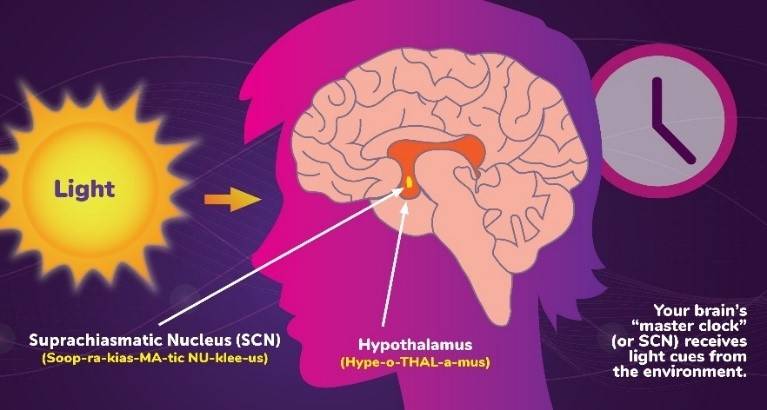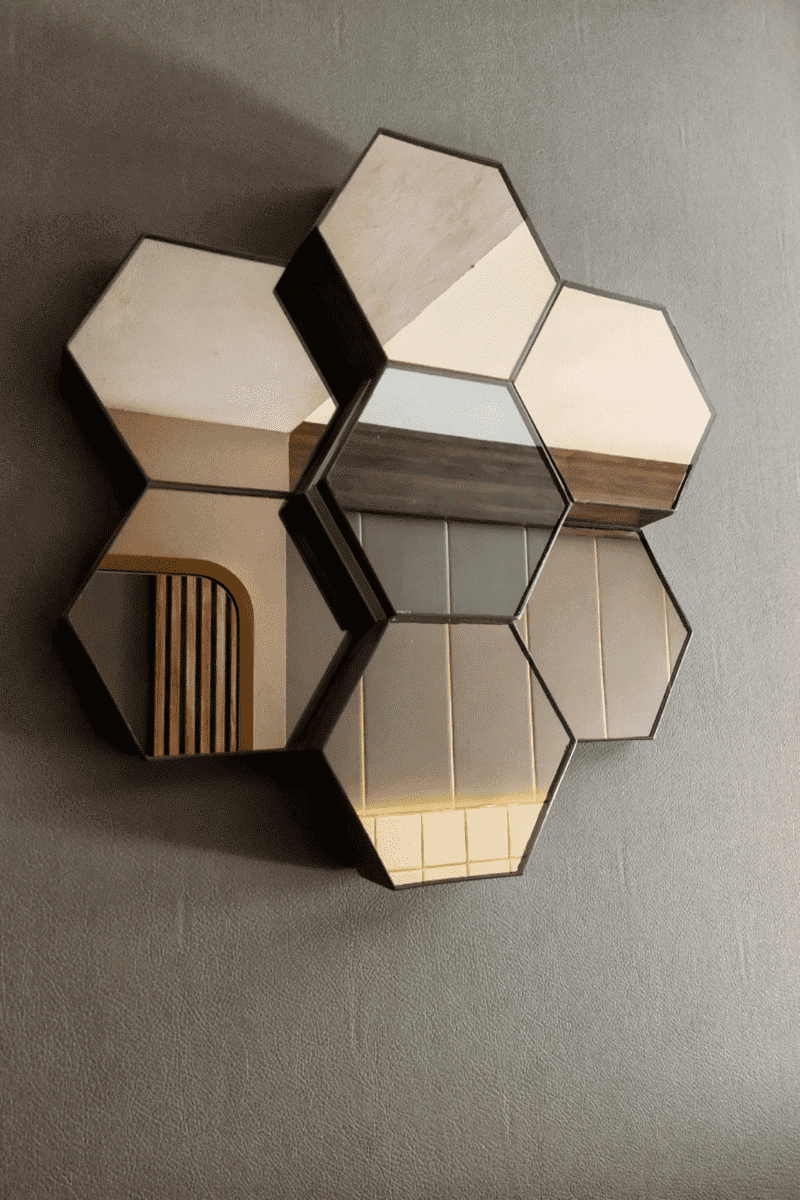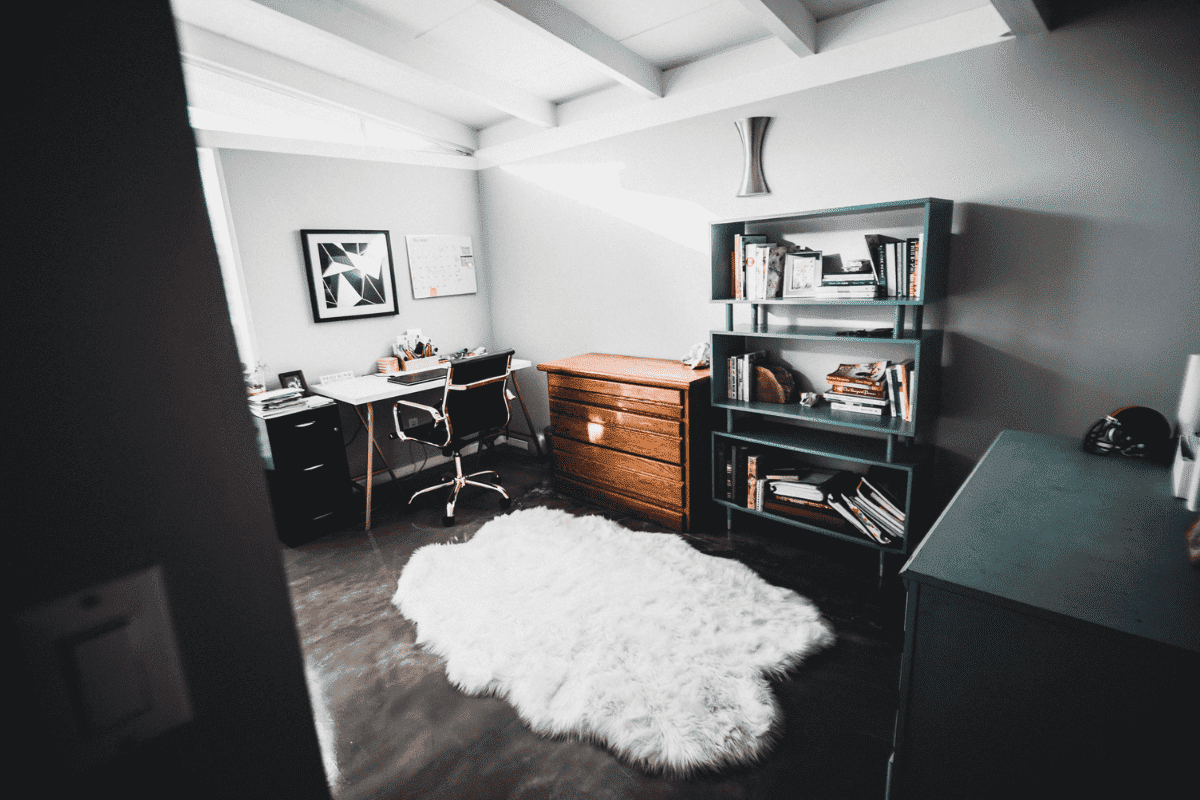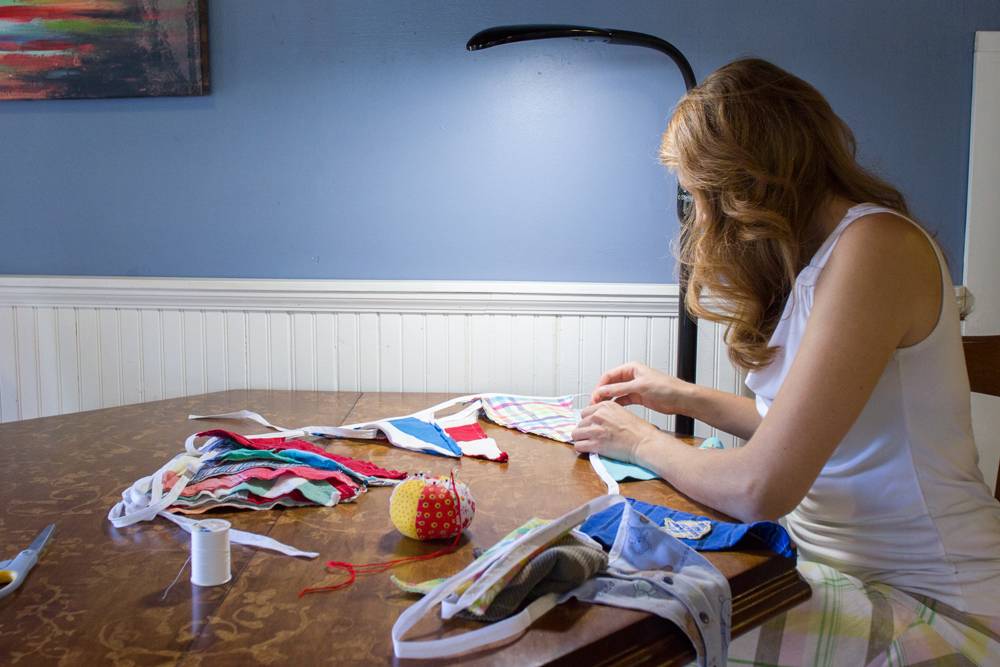I held my daughter close one February afternoon, enjoying a few moments of serenity as warm sunshine poured down on us from a wintry blue sky. Just moments ago, my almost-two-year-old toddler had been kicking and screaming in the playground parking lot, refusing to don her winter boots. With the promise of a ride on the swings — something she hadn’t done in weeks thanks to a frigid and snowy New England winter — she finally relented. Now, standing together in the middle of the sun-drenched playground, we are the picture of tranquility.
Lighting, whether natural or artificial, affects so much more than our ability to see. It can impact our mood, our mental health, even our physical well-being. Wherever you are reading this post, take a look around and assess your lighting. Are you in a dark room, using only the blue light from your device to illuminate the text on the screen? Is there an overhead light and/or a task light in your space? Are the shades drawn? By bringing awareness to our lighting environment, we can begin to understand the ways in which lighting affects our overall health, well-being, and state-of-mind.
More than meets the eye: the effect of lighting on our health and well-being

Credit: Soraa.com
Lighting is so important to both our mental and physical health. It can impact our mood, ability to concentrate, and even our sleep.
In this article, we’ll cover the following areas:
- How lighting affects our mental health and physical well-being.
- Ways that we can improve our home lighting environment.
Finally, we’ll dive a little deeper into a specific mental health condition known as SAD, or seasonal affective disorder, and how light therapy and LEDs in particular can be used to mimic sunlight during the winter months.
Let’s start by taking a look at how lighting affects our mental health in general.
How lighting affects our mental health
Light has been shown to impact brain chemistry. It can decrease melatonin — the hormone that makes us sleepy and has been linked to depression — and increase levels of serotonin and noradrenaline, two chemicals that can have a positive effect on our mood, outlook, and energy. What’s more, light can be used as an effective therapeutic option to improve sleep, mood and general well-being.
Light can also affect our cognitive performance such as reaction time and activation. Variable lighting that is specific to the task at hand can help us be more efficient and productive. For example, a person working with physical documents will work better under the right lighting condition: a task light that is directed specifically at their reading material (rather than an overhead light, which only offers a small fraction of the illumination provided by a dedicated task lamp).

Place your task under a direct light source.
Now, let’s take a look at a few scientific studies exploring the effect of light on our mental state.
- An Australian study found that people had higher levels of serotonin on bright sunny days than on cloudy days, no matter how hot or cold the temperature outdoors.
- In another study, researchers were able to effectively mitigate negative mood in the elderly through lighting. After watching a short film intended to induce anxiety, participants were immersed in two different types of lighting (either “cozy” or “neutral” lighting). The results showed that the “cozy” ambience was more effective at calming the anxious participants than the neutral space.
- In Finland, where daylight can be as short as 6 hours in the winter, researchers found that people were happier, less hostile, and more alert after using special lamps designed to resemble sunlight during the winter months.
Lighting and physical health
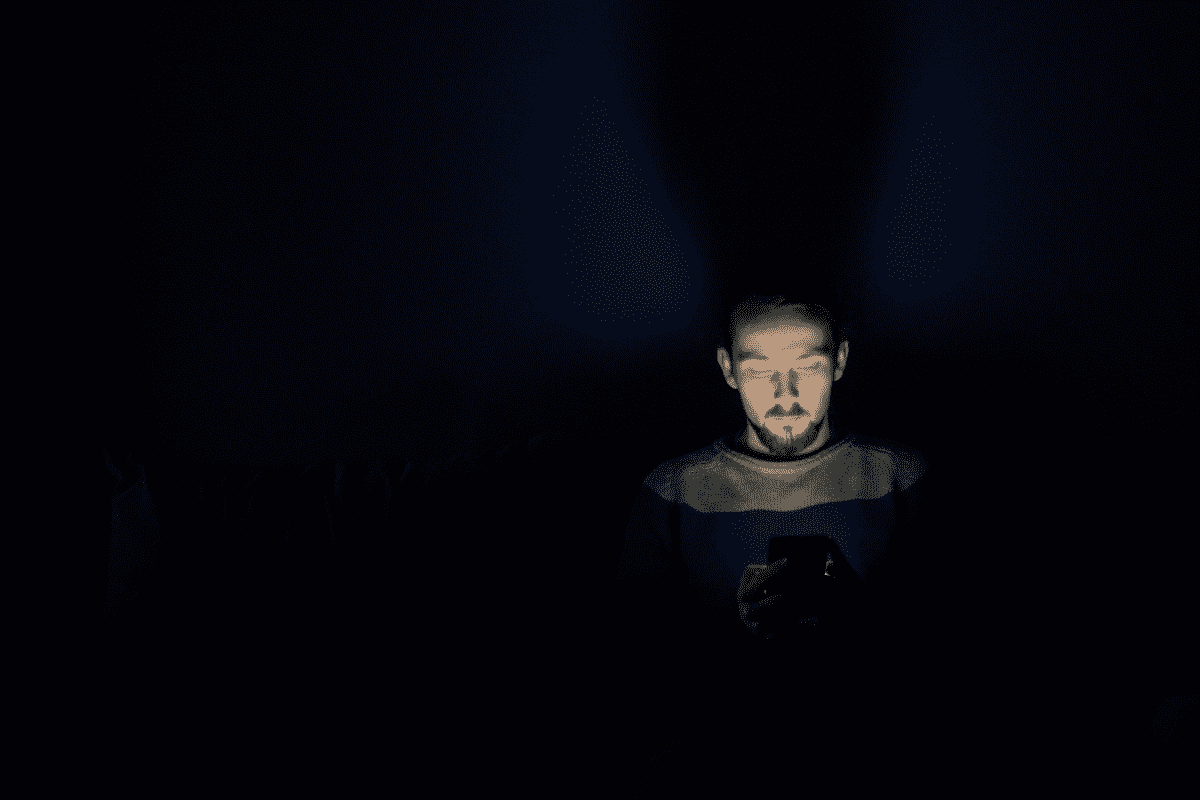
Lighting not only affects our mental health but also our biology. Lighting can reduce eye strain, stabilize our circadian rhythms, and affect our blood pressure, heart rate and body temperature.
Circadian rhythms
The body’s 24-hour sleep/wake cycle, a circadian rhythm, is crucial to many systems throughout the body, such as the digestive and endocrine systems. It is also very sensitive to light. The brain has what is known as a “master clock,” or a circadian pacemaker, that is responsible for sending signals to regulate activity throughout the body. Light exposure during the day causes the master clock to send signals that keep us awake, alert and active; while at night, the master clock stimulates the production of melatonin, a hormone that induces sleep.
Blue light, such as the light emitted from a phone or laptop, can suppress melatonin production and interfere with sleep. Studies show that shift workers, who work at night and don’t get as much exposure to daylight, may produce less melatonin, which may lower production of important chemicals the body uses to repair DNA. Unfortunately, this chemical disruption could potentially lead to more cell mutations triggering cancer. Circadian rhythms also influence our metabolism and immune system, and shift workers who consistently sleep during the day and work at night tend to be heavier. Interference with the natural light/dark cycle can also impact the strength of our immune system as well as our mood and energy levels.
Learn more about the body’s circadian rhythm in this short video.
Research shows a connection between light and cardiovascular physiology, including how light intensity can affect our blood pressure, heart rate, and body temperature.
In one experiment, researchers measured the cognitive performance, alertness, and mood of the participants in a simulated hospital operating room. A LED surgical lamp, flexible in both spectrum and intensity, was used as the light source. The results showed a relationship between the color temperature and luminance of the light and the participants’ cognitive performance, alertness and mood.
Home lighting environment
Clearly, lighting plays a key role in both our mental health and biological processes. So, it’s important that we not take our lighting environment for granted. Let’s consider how we can assess and improve our home lighting situation.
First, how much natural light does your house get during the day? Using a few interior design tricks, you can increase the amount of light in your home without breaking the bank. The key is to maximize your home’s natural light while using well-thought out artificial lighting as a complement. Here are some ideas from Decorated Life to get started.
- Use mirrors to reflect and amplify the light entering through your windows.
- Choose light paint colors for your walls and ceilings. Whites, off-whites, and light greys can brighten up the space. Light-colored woods for floors, trim and furniture can have a similar effect. If you want a pop of color, choose pastels, bright yellows or bright greens.
- If painting isn’t an option, choose a large, lightly-colored area rug to brighten up a dark room. Or, select light fabrics for your upholstery.
- White curtains will help reflect natural light and can even make windows seem larger if hung slightly taller and wider than the size of the window frame.
- Angle furniture (such as couches, desks, and kitchen tables) toward windows to access as much natural light as possible during the day.
- Don’t rely solely on overhead lights to illuminate rooms. Consider adding other light sources such as floor lamps, table lamps, and task lamps, depending on how the room is used. For example, if you like to read in bed at night, you might want to clamp a task lamp with an adjustable neck to your nightstand.
- Another great lighting option is overhead recessed lighting, which consists of rows of small, hockey-puck sized lights that distribute light evenly across a room.
- Replacing dark lampshades with white or off-white shades will allow more light to shine through.
- Finally, choose your artwork and accent furniture wisely. Too much clutter will darken the space.
Task lighting, simplified
Task lighting is now easier than ever with portable, rechargeable options such as the Stella GO, which boasts an unprecedented 11 hour battery life on a single charge. Whether you are traveling or simply completing chores around the house, you can take the lamp wherever you need task lighting. The Stella GO can even charge your phone! Learn more about Stella GO here.

The new Stella GO rechargeable desk lamp with wireless charging pad
Light therapy boxes
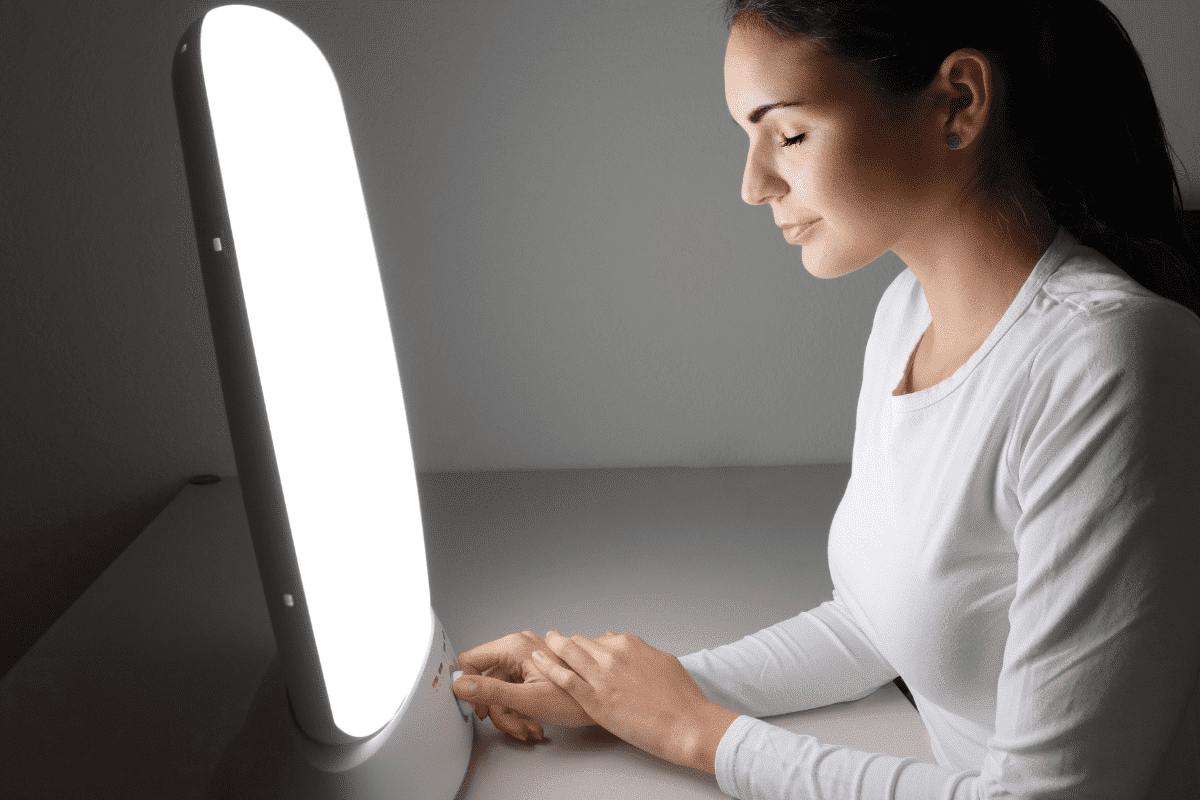
According to the National Institute of Mental Health, millions of Americans may suffer from seasonal affective disorder, or SAD, although many be unaware of their condition. It is more common in those living farther north, where daylight hours are shorter in the winter.
What is SAD?
SAD is a type of depression causing significant changes in mood and behavior when the seasons change. Since lack of light during the winter can throw off our circadian rhythm, the brain may end up producing too much melatonin and not enough serotonin, causing a chemical imbalance and making us feel low and lethargic. Those with SAD may also experience problems with concentration, working memory, and overeating.
Luckily, those suffering from SAD may be able to find relief through light therapy. Light therapy consists of sitting near a light therapy box that shines bright white light, similar to natural sunlight, for a total of 30 minutes per day.
A light therapy box uses fluorescent or LED bulbs to produce a bright white light in a color temperature between 5000-6500K, consistent with the color temperature of the sun at noon. By comparison, LED lamps such as the Stella TWO LED Task Lamp feature tri-spectrum bulbs that can simulate a range of natural light, from sunlight to moonlight.
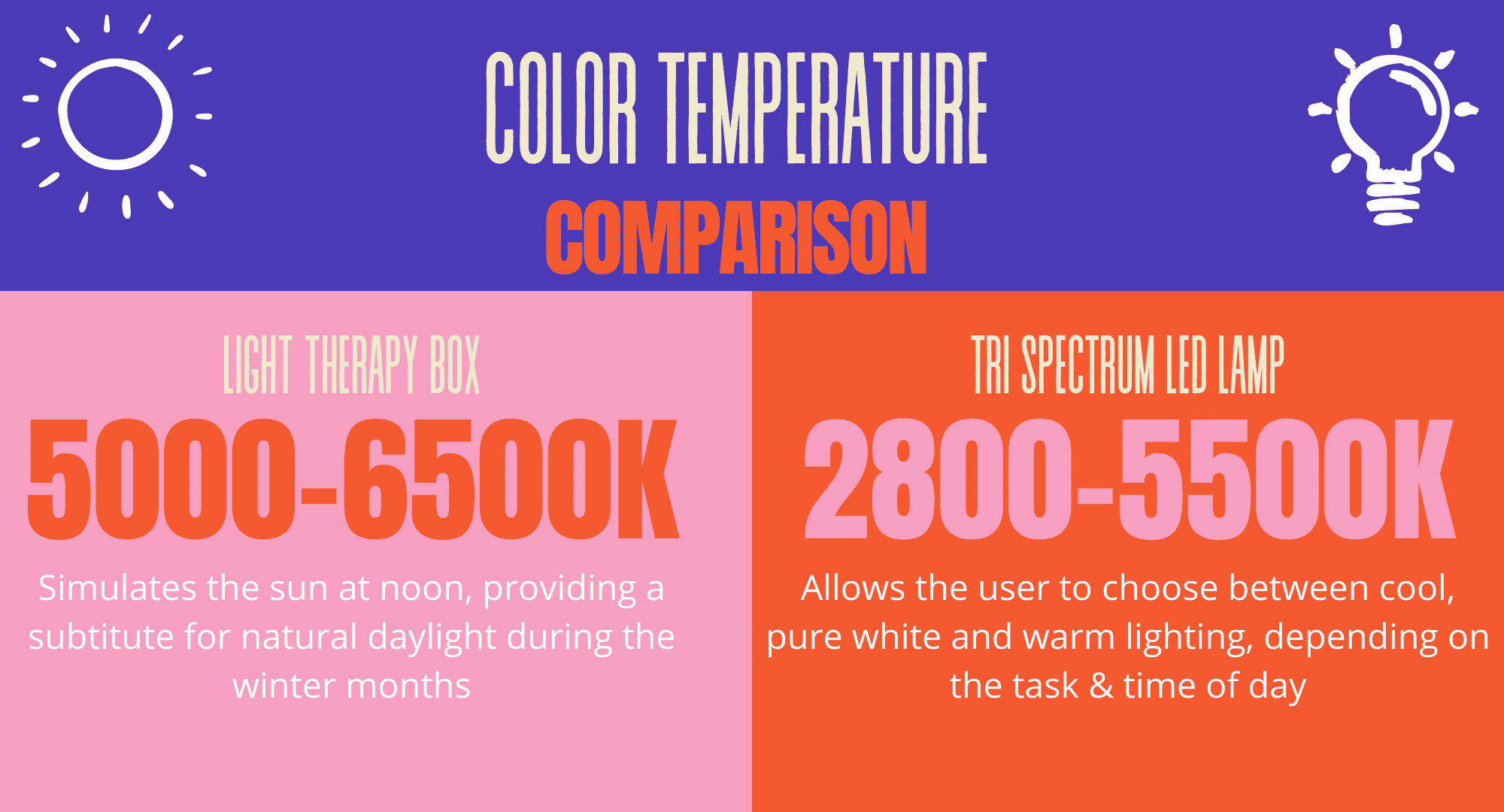
Open the “Color Temperature Comparison” infographic transcript
Though tri-spectrum LED bulbs are not intended for use as light therapy, they can serve as a therapeutic complement by enhancing the home with simulated natural light. As an added bonus, LEDs are more economical and more durable than traditional bulbs.
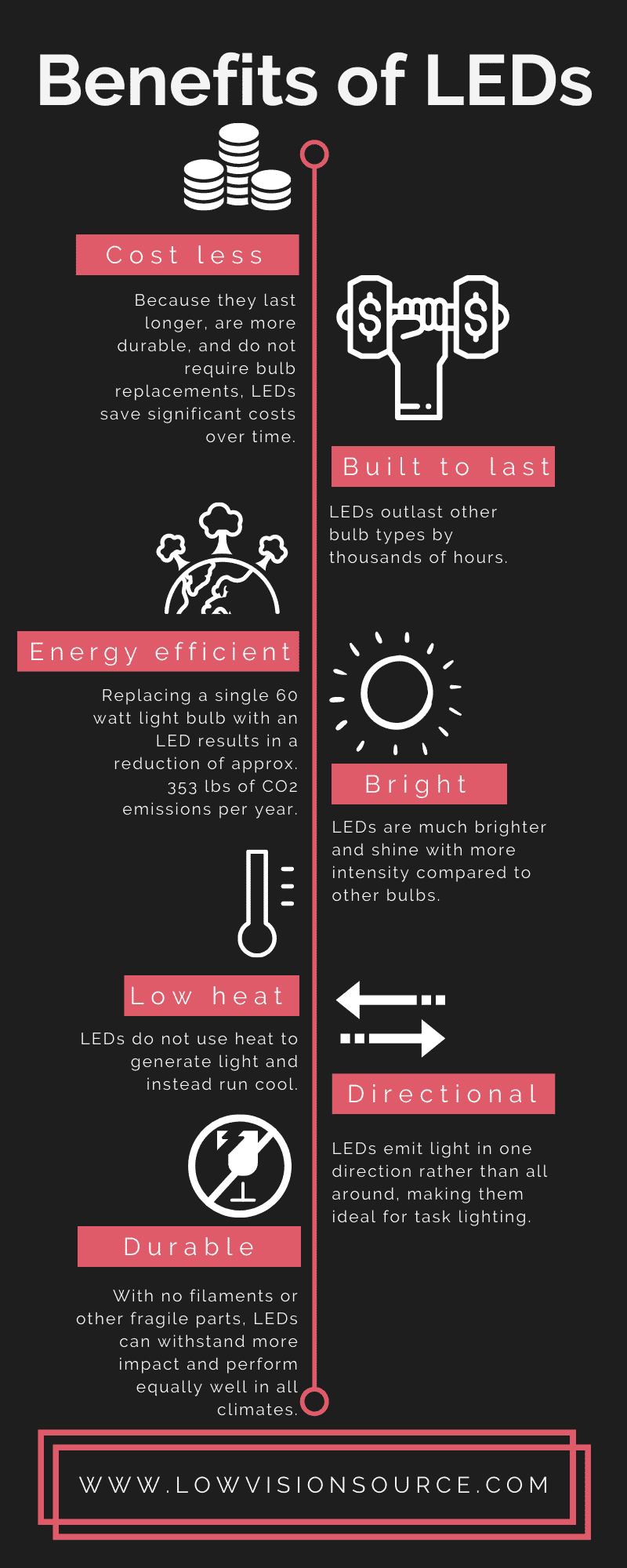
Sources: thelightbulb.co.uk, usatoday.com
Open the “Benefits of LEDs” infographic transcript
Final thoughts on lighting and health
Let’s wrap up our discussion by bringing awareness back to our current lighting environment. Consider the room you are in, or another room in your home that you use frequently. Ask yourself the following five questions:
- Can I see well in this space, or do my eyes feel tired?
- Does the lighting fit the function of the room?
- How is my energy level affected by the light source(s) in the room?
- How does this room make me feel? Do I feel creative, energized, relaxed, or otherwise?
- Are there ways in which I can improve the room’s lighting environment?
Whether you are in sunny Florida, or you’re like us New Englanders, counting down the days till the sun is out past 4pm in the winter, lighting is crucial to your mental and physical well-being. And, improving your home’s lighting environment is one way of caring for yourself and your loved ones. To borrow a phrase from ancient Rome, let’s make an effort to “live in rooms full of light,” and take advantage of simple changes that can bring lasting benefits to our health and well-being.
Last updated September 15, 2023.
Author Information
By Bethany Wyshak. Reviewed by Stuart Flom.
Sources
A. (2020, August 13). Finland’s weather and light. ThisisFINLAND. https://finland.fi/life-society/finlands-weather-and-light/
Abo-Ras, H., Ashqer, I., & El Hasan, M. (2014, January 1). The effect of light intensity on blood pressure, heart pulse rate, blood oxygen saturation and temperature of children in Jenin-City Schools. Research Gate. https://www.researchgate.net/publication/262206617_The_effect_of_light_intensity_on_blood_pressure_heart_pulse_rate_blood_oxygen_saturation_and_temperature_of_children_in_Jenin-City_Schools
Blume, C., Garbazza, C., & Spitschan, M. (2019). Effects of light on human circadian rhythms, sleep and mood. Somnologie, 23(3), 147–156. https://doi.org/10.1007/s11818-019-00215-x
Chellappa, S. L., Lasauskaite, R., & Cajochen, C. (2017). In a Heartbeat: Light and Cardiovascular Physiology. Frontiers in Neurology, 8, 1. https://doi.org/10.3389/fneur.2017.00541
Decorated Life. (2021, February 9). 20 Creative Ways to Get More Natural Light in Dark Rooms. https://decoratedlife.com/10-ways-natural-light-dark-rooms/
Foley, L. (2020, September 25). What is Circadian Rhythm? Sleep Foundation. https://www.sleepfoundation.org/circadian-rhythm
Harvard Health Publishing. (2019, November 1). Shining a light on winter depression. Harvard Health. https://www.health.harvard.edu/mind-and-mood/shining-a-light-on-winter-depression
Healthlighting.com. (2020, January 29). Does full spectrum lighting help seasonal depression? https://healthlighting.com/blogs/wellness/does-full-spectrum-lighting-help-seasonal-depression
Kuijsters, A., Redi, J., de Ruyter, B., & Heynderickx, I. (2015). Lighting to Make You Feel Better: Improving the Mood of Elderly People with Affective Ambiences. PLOS ONE, 10(7), e0132732. https://doi.org/10.1371/journal.pone.0132732
Li, H., Wang, H., Shen, J., Sun, P., Xie, T., Zhang, S., & Zheng, Z. (6 September 2017). Non-visual biological effects of light on human cognition, alertness, and mood. Proc. SPIE 10367, Light in Nature VI, 103670D. https://doi.org/10.1117/12.2272555
Lutz, A. (2023, August 24). How to modify a home for low Vision. Architectural Digest. Retrieved September 14, 2023, from https://www.architecturaldigest.com/reviews/home-improvement/low-vision-home-modifications
National Institute of Mental Health. (2006, December). Seasonal Affective Disorder. https://www.nimh.nih.gov/health/publications/seasonal-affective-disorder/20-mh-8138-sad_161206.pdf
Park, A. (2017, August 7). Why Sunlight Is So Good For You. Time. https://time.com/4888327/why-sunlight-is-so-good-for-you/
Romocean, M. (2020, November 6). The Psychological Impact of Light & Color | TCP Lighting Solutions. TCP Lighting. https://www.tcpi.com/psychological-impact-light-color/#:%7E:text=It%20can%20improve%20mood%20and,as%20reaction%20time%20and%20activation
Sample, I. (2003, April 24). Why are we happier when the sun is out? The Guardian. https://www.theguardian.com/science/2003/apr/24/thisweekssciencequestions3
SciShow. (2014, January 10). Circadian Rhythm and Your Brain’s Clock [Video]. YouTube. https://www.youtube.com/watch?v=UbQ0RxQu2gM
Zetlin, M. (2021, January 5). 5 Surprising Ways Lighting Can Improve Your Mood, Productivity, and Health. Inc.Com. https://www.inc.com/minda-zetlin/5-surprising-ways-lighting-can-improve-your-mood-productivity-and-health.html

